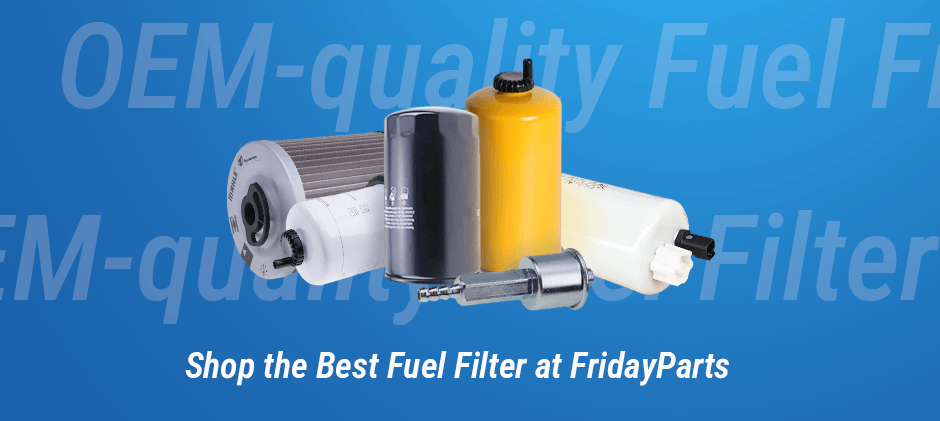Have you ever felt your tractor, loader, or other equipment start sputtering while driving? The engine light flicks on, and you’re left wondering what is going on. That actually could be as simple as a bad fuel Filter. Act as lungs among all engine spare parts, a clogged fuel filter can lead to reduced fuel efficiency. If your engine is consuming more fuel than usual or you are experiencing engine misfires from time to time, it might also be a sign that your fuel filter needs replacing. Don’t worry, replacing it is easier than you think. Let’s break it down into 8 easy steps so you can get back on the road in no time.
How do I know when my fuel filter needs to be replaced? Explore more fuel filter replacement symptoms, please read: 10 Signs of a Bad Fuel Filter You Can’t Ignore
Tools and Materials
Before you begin, gather the following tools and materials:
- New fuel filter (compatible with your vehicle model)
- Wrench set
- Pliers
- Screwdriver
- Safety glasses
- Gloves
- Rags or paper towels
- Fuel line disconnect tool (optional)
- Fire extinguisher (for safety)
8 Easy Steps to Replace Your Fuel Filter
Step 1: Prepare Your Vehicle
Park your vehicle on a level surface and engage the parking brake. Relieve fuel system pressure by removing the fuel pump fuse or relay and running the engine until it stalls.
Step 2: Locate the Fuel Filter
Consult your vehicle’s manual to find the fuel filter location. It’s typically along the fuel line, either under the car or in the engine bay.
Step 3: Disconnect the Battery
For safety, disconnect the negative terminal of your car’s battery.
Step 4: Position a Drip Pan
Place a drip pan under the fuel filter to catch any spilled fuel.
Step 5: Remove the Old Fuel Filter
Carefully disconnect the fuel lines from the old filter. Use a fuel line disconnect tool if necessary. Remove any clamps or bolts securing the filter.
Step 6: Install the New Fuel Filter
Insert the new fuel filter, ensuring it’s oriented correctly. The arrow on the filter should point in the direction of fuel flow (towards the engine).
Step 7: Reconnect Fuel Lines and Secure the Filter
Reattach the fuel lines to the new filter, making sure they’re securely connected. Reinstall any clamps or bolts.
Step 8: Test the System
Reconnect the battery and reinstall the fuel pump fuse or relay. Turn the ignition to the “ON” position (without starting the engine) to pressurize the system. Check for leaks around the new filter. If there are no leaks, start the engine and verify proper operation.
How Often Should a Fuel Filter be Changed?
The table below summarizes the recommended replacement intervals for different vehicle types:
| Vehicle Type | Recommended Replacement Interval |
|---|---|
| Gasoline | Every 20,000 – 30,000 miles |
| Diesel | Every 10,000 – 25,000 miles |
| High-Performance | Every 10,000 – 15,000 miles |
Remember, these are general guidelines. Always consult your vehicle’s manual for specific recommendations.

Fuel Filter Replacement Cost
Replacing a fuel filter isn’t usually a wallet-buster, but the price can swing a bit. On average, you’re looking at about $70 to $250 for the whole shebang. That includes both parts and labor.
Here’s a quick breakdown:
- The filter itself? Usually between $10 and $30.
- Labor costs? Expect to shell out $90 to $115.
Now, if you’re driving a fancy ride or a diesel, it might cost you a bit more. Some high-end cars use pricier filters that can run up to $100.
Feeling handy? You could save some cash by doing it yourself. The part’s only about $20 at your local auto store. But hey, if you’re not sure what you’re doing, it’s probably best to leave it to the pros. There are a few things that might bump up the price:
- If your filter’s hiding in a tough spot
- If you’re cruising in a luxury or sports car
- If the mechanic finds other issues while they’re at it
Always ask for a quote before giving the green light. And check your car’s manual – some newer models don’t even need their filters replaced. But if you come to FridayParts, you will only find fuel filter solutions cheap and high-quality. We provide all kinds of fuel filters, aiming to refresh your diesel engine and make it run at peak.
Conclusion
I believe that by following the aforementioned 8 steps, you can be a fuel filter replacement master yourself. Regular fuel filter replacement costs less but returns more in engine efficiency. By choosing FridayParts fuel filter, you can enjoy saving and a smooth diesel ride. Shop now and become a FridayParts member and enjoy more exclusive perks!

